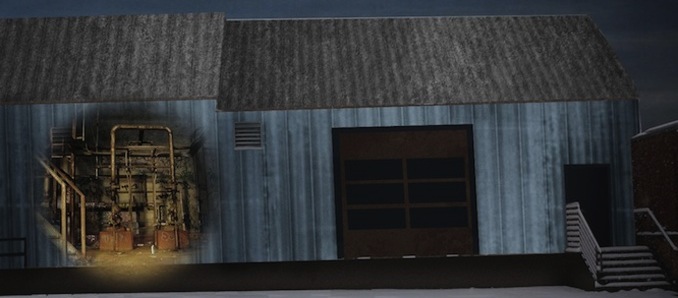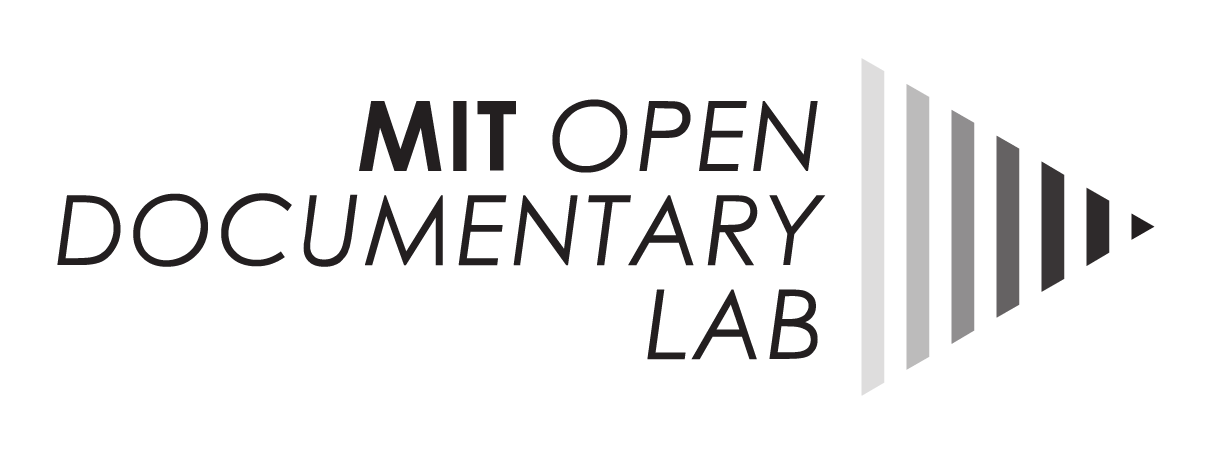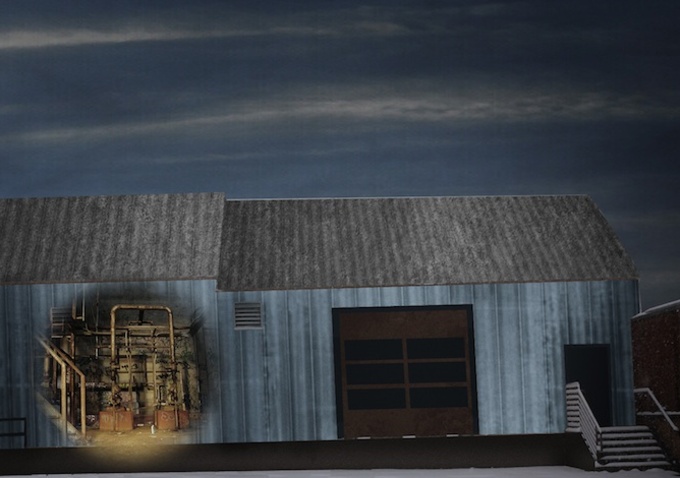
29 Jan What Sundance’s New Frontier Is Building In (and Out) There
The OpenDocLab teamed up with Indiewire and the Sundance Institute to publish a series of articles about the 2013 Sundance New Frontier festival, written by OpenDocLab research assistants. This was previously published in Indiewire’s Criticwire blog, and is reposted with permission.
What Sundance’s New Frontier Is Building In (and Out) There
Julie Fischer
The cold isn’t the only thing giving people the shivers at Sundance’s New Frontier.
“What’s He Building In There?” conjures the same mix of creeps and curiosity that fuels the Tom Waits’ song of the same name. Artist Ricardo Rivera and his team Klip Collective re-imagine Waits’ throaty growl about a suspicious neighborhood shut-in as a massive moving 3D projection on the outside walls of the New Frontier venue.
The show starts when the sun goes down, and the industrial-style New Frontier complex glows in the darkness. Under the transformative glare of four powerful projectors, the walls begin to quiver and then collapse, revealing a strange fictional interior that looks like the meat packing plant from hell. Gears and blades spin wildly. Wires leak sparks and electric currents. A groaning conveyor belt sends truck-sized chunks of wriggling red meat along the length of the building. A lone lurching figure in overalls tinkers at a tin-can supercomputer. Later, the mailman stops by.
[vimeo]http://vimeo.com/57635423[/vimeo]
What makes this piece absolute macabre fun to watch is the compelling if shadowy story arc that’s unfolding. The fictional walls rise and fall, creating windows, peepholes, and orbs of x-ray vision that grab and guide audience attention. Our antihero tinkers with bits of machinery, then gets out of his seat and scurries out of sight around the corner of the building. We’re invited to play the role of nosy neighbor, trying to puzzle out what on earth is going on.
But this narrative is built for casual viewing as much as it is for rapt attention. Projecting the piece on the outside of the venue is a declaration that people are equally as welcome to stick around as they are to take a quick peek on their way in or out of New Frontier. In fact, it even turns those passersby into parts of the show for viewers who are taking a lengthier look. The “What’s He Building In There?” projection includes a set of whirring pistons and metallic jaws that clamp around the edges of the actual New Frontier venue doors. From a vantage point further away from the building, it’s easy to think that the festivalgoers walking inside might have some connection to the projected hunks of raw meat rolling out of the opposite wall.
There is a playfulness to the way the narrative of “What’s He Building In There?” unfolds, not too concerned with how people choose to see the piece but full of hidden delights for those who watch from start to finish. If you do experience the full built-in narrative arc, it is immediately clear that this piece is something distinct from the two other 3D projection works on display in the actual interior at New Frontier this year. “Cityscape 2095” and “Eyjafjallajokull” were both created by artists from the AntiVJ label. These pieces are dazzling works of art and their animation is arresting, employing hand-drawn elements coupled with precision projection to render two diverse landscapes: the sprawling city of the future, and the ash-gray approach of Iceland’s Eyjafjalojokull volcano.
Like “What’s He Building In There?” these pieces are playing with our sense of space. In “Cityscape 2095,” artists Yannick Jacquet, Mandril, and Thomas Vaquiée built their beautiful metropolis behind a glass partition segmented like window panes, so that the hallways in which it stands feels like a sky deck for viewers to observe the streets below. “Eyjafjalolokull” artist Joanie Lemercier sets his wire-frame rendering of a mountainous horizon as a floor-to-ceiling work, adding to the impression that visitors could walk straight into the strange visualization of this landscape. But while the imagined space is rich and vivid, the actual space of the audience is not a part of these works. Viewers sit or stand in isolating darkness, the only light is on the engrossing visions set into the walls. These pieces encourage solo, silent contemplation. The immersion here is powerful, but it is the type that remains in the viewers’ own head.
The unique feature of “What’s He Building In There?” is that in opening itself to being less immersive — in an outdoor space subject to noise, interruption and people passing through — it becomes thoroughly communal. Viewers can mingle and chat, while grabbing a bite to eat at one of the conveniently situated food trucks or under the coveted glow of a heat lamp. They can point out a newly discovered detail to their friends. The loose narrative of the work gives viewers toeholds to engage with it and to get others around them to engage, too. It invites viewers to nudge each other and whisper under their breath about what they think is going on. And that seems like an immersion of a different kind, a means of using physical space for cinematic involvement that is built by the audience together. Viewers are drawn into the piece not just for its dark charms alone, but for the thrill of pondering the question on everyone’s mind: “What is he building in there?”
Julie Fischer is a first year graduate student in MIT’s Comparative Media Studies program. She is a research assistant for the Open Documentary Lab.




